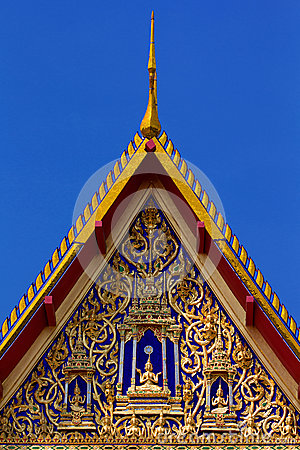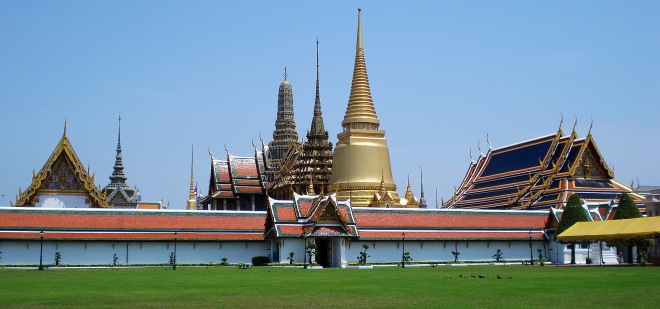Bangkok, 13 December 2015
I’m not a great fan of Thai religious art. Much of it seems to be made up of endlessly repeated and very dense geometricized forms, like on this temple door
or on this one, where the temple guardians or whatever they are have been surrounded by dense geometricized foliage
or here on a temple’s roof gable, where it is now a representation of the Buddha that is surrounded by endless curlicues
and which often in Bangkok are terrifically bling, being made with reflecting coloured mosaic tesserae (I understand that only temples with royal connections can use these reflecting tesserae).
Or on the so-called bargeboards which run along the gables
the designs often representing, as is clearly the case here, a naga snake; the naga snake design is less obvious in this next photo.
The interiors of the temples are not much better, with the walls normally being densely carpeted either with an endlessly repeating series of Bodhisattvas or some such, or with very dense scenes of the life of the Buddha or some similarly holy personage.
As I’ve mentioned in at least one previous posting, I’m not a great fan of busy artwork, so I generally feel uncomfortable in Thai temples. The one exception is my feelings for the chofah. Chofahs are the very distinctive finials added to the end of temple roofs, and which are quite striking, especially from a distance. Here are two views of Wat Phra Kaew in Bangkok, showing that temple’s chofahs, this one from a certain distance
and this one from closer up.
What exactly are they? What do they represent? Well, the literal meaning of chofah is “bunch of air” although someone has given it the more poetic translation of “sky tassel”. The name may be poetic but I don’t feel it helps much, since I don’t see any obvious connection between what I see before me and bunches of air or tassels, skywise or otherwise. More helpfully, they are generally considered to be representations of the Garuda, the half-bird, half-man which the Indian God Vishnu is said to fly on (and which is now the national emblem of Thailand), although there is a competing theory that actually they represent the hamsa, which is a goose, or a gander, or maybe even a swan, which in Hindu mythology is the mount of the God Brahma. Whichever it is, there is a definite resemblance to a bird. Looking at the last picture, I think it’s easy to see a head, a beak, a neck, and a breast of a bird (what’s a little less birdlike is the long tuft-like extension on the head; we’ll come back to that in a minute). Contrary to the baroque ornateness of everything else in Thai temples, we have here a simple ornament, where resemblance is implied with a few graceful strokes chiseled into wood.
Just to make the bird connection a bit stronger, I throw in a picture here of a brahminy kite sitting on a stone.
I choose this particular bird because it is currently considered the contemporary representation of the Garuda. More irreverently, I also throw in a picture of the cover page from one of Lucky Luke’s comic books, where the reader will note another raptor, the vulture.
Vultures are always hovering around in Lucky Luke’s stories, waiting for their next meal in the form of a dead Lucky Luke or other dead meat; note the drop of saliva falling from the beak – it’s looking forward to that meal of dead meat …
If I introduce comic books, it’s because that tuft-like extension on the chofah stirs a vague memory in me of some comic-book bird with a long tuft on its head. Maybe I’m thinking of Woody Woodpecker.
But Thai temple builders definitely weren’t thinking of Woody or anyone else when they added that long tuft to their chofah design. They originally believed that the tuft would actually act as a skewer and protect the temple from flying demons by impaling them should they get too close.
So maybe the chofah is a sort of lightning conductor before its time.
____________
Temple door-1: http://static5.depositphotos.com/1031223/456/i/950/depositphotos_4560014-Golden-Buddhist-temple-door-at-Wat-Phoechai-Loa..jpg (in http://depositphotos.com/4560014/stock-photo-golden-buddhist-temple-door-at.html)
Temple door-2: http://previews.123rf.com/images/trahcus/trahcus1007/trahcus100700017/7330394-Thai-style-painted-door-Stock-Photo-door-golden-temple.jpg (in http://www.123rf.com/photo_7330394_thai-style-painted-door.html)
Roof gable: http://thumbs.dreamstime.com/x/wat-thai-temple-decorations-phra-kaew-bangkok-thailand-30782920.jpg (in http://www.dreamstime.com/stock-photo-decorations-wat-phra-kaew-details-temple-emerald-buddha-bangkok-thailand-image47184437)
Bargeboards-1: http://www.asiaexplorers.com/pics/gable-northern-thai-temple.jpg (in http://www.asiaexplorers.com/thailand/northern-thai-temple-architecture.htm)
Bargeboards-2: http://thumbs.dreamstime.com/x/buddhist-temple-roof-detail-thailand-46162088.jpg (in http://www.dreamstime.com/stock-images-buddhist-temple-thailand-phra-choeng-chum-ornate-thai-town-sakon-nakhon-image35533934)
Temple interior: my wife’s pic
Chofahs – Wat Phra Kaew from a distance: http://www.gigaplaces.com/place/144_max.jpg (in http://www.gigaplaces.com/en/gigaplace-wat-phra-kaew-144/)
Chofahs – Wat Phra Kaew: http://photos1.blogger.com/blogger/6018/1224/1600/Bangkok%20-%20Wat%20Phra%20Kaew%20301.jpg (in http://marcsala.blogspot.com/2005/09/temple-guardians-in-thailand.html)
Brahminy kite: http://voices.nationalgeographic.com/files/2013/05/Brahminy-Kite-Gururaj-Moorching-600×822.jpg (in http://voices.nationalgeographic.com/tag/macaw/feed/)
Vulture in Lucky Luke: http://1.bp.blogspot.com/-m2HaZEeDsfk/VYQHOyjtjAI/AAAAAAAASMo/NJ805YwsIWs/s1600/LuckyLuke46a.jpg (in http://mysterycomics-rdb.blogspot.com/2015/06/critique-648-lucky-luke-tomes-43-46-le.html)
Woody Woodpecker: http://vignette4.wikia.nocookie.net/woodywoodpecker/images/4/44/477098-villi.jpg/revision/latest?cb=20141107234707 (in http://woodywoodpecker.wikia.com/wiki/Woody_Woodpecker)











I think more along the lines of “gazelle” when I see it, but pretty sure they don’t natively have gazelles in Thailand so probably not it 😉
LikeLike